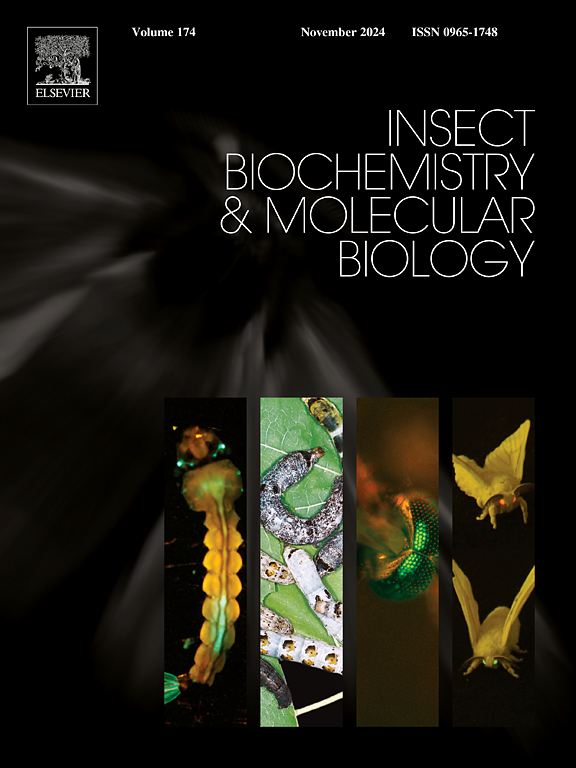Ultrabithorax inhibits the expression of myc by directly binding to its 5′-UTR in the posterior silk gland of Bombyx mori
IF 3.7
2区 农林科学
Q2 BIOCHEMISTRY & MOLECULAR BIOLOGY
引用次数: 0
Abstract
Ultrabithorax (Ubx) is a famous gene for insect body segment determination and c-myc plays a crucial role in cell fate and is well-known as proto-oncogene. As two pivotal transcription factors, whether there is a regulatory relationship between them has not yet been reported. In our previous research, we found that excess Ubx can strongly repress the expression of Myc in the posterior silk gland of Bombyx mori (B. mori). One unresolved question is whether Ubx inhibits the Myc expression directly or indirectly. In our current study, multiple Ubx binding sites were identified from the upstream sequence and 5′-UTR of Myc. Meanwhile, the expression profile data in silkDB 3.0 showed that Ubx and Myc were expressed simultaneously in multiple tissues and developmental stages of B. mori. Luciferase reporter assay results indicated that overexpressed Ubx down-regulated the activity of luciferase which was activated by the upstream sequence and 5′-UTR of Myc in BmN cells. Electrophoretic Mobility Shift Assay (EMSA) confirmed that Ubx bound to the 5′-UTR of Myc directly. Prediction results and ChIP-Seq data suggested that this interaction might be widespread in insects. In conclusion, our study uncovered the relationship between two famous gene, Ubx and Myc, which play critical regulatory roles in insect growth and development.

Ultrabithorax通过直接结合家蚕后丝腺中Myc的5'-UTR抑制Myc的表达。
Ultrabithorax (Ubx)是一个著名的昆虫体段决定基因,c-myc在细胞命运中起着至关重要的作用,是众所周知的原癌基因。作为两个关键的转录因子,它们之间是否存在调控关系尚未见报道。在我们之前的研究中,我们发现过量的Ubx可以强烈抑制家蚕(B. mori)后丝腺Myc的表达。一个尚未解决的问题是Ubx是否直接或间接抑制Myc的表达。在我们目前的研究中,从Myc的上游序列和5'-UTR中鉴定了多个Ubx结合位点。同时,在silkDB 3.0中的表达谱数据显示,Ubx和Myc在家蚕的多个组织和发育阶段同时表达。荧光素酶报告基因检测结果显示,Ubx过表达下调了BmN细胞中Myc上游序列和5′-UTR激活的荧光素酶活性。EMSA (electrophotic Mobility Shift Assay)证实Ubx与Myc的5'-UTR直接结合。预测结果和ChIP-Seq数据表明,这种相互作用可能在昆虫中广泛存在。总之,我们的研究揭示了两个著名的基因Ubx和Myc之间的关系,这两个基因在昆虫的生长发育中起着关键的调节作用。
本文章由计算机程序翻译,如有差异,请以英文原文为准。
求助全文
约1分钟内获得全文
求助全文
来源期刊
CiteScore
7.40
自引率
5.30%
发文量
105
审稿时长
40 days
期刊介绍:
This international journal publishes original contributions and mini-reviews in the fields of insect biochemistry and insect molecular biology. Main areas of interest are neurochemistry, hormone and pheromone biochemistry, enzymes and metabolism, hormone action and gene regulation, gene characterization and structure, pharmacology, immunology and cell and tissue culture. Papers on the biochemistry and molecular biology of other groups of arthropods are published if of general interest to the readership. Technique papers will be considered for publication if they significantly advance the field of insect biochemistry and molecular biology in the opinion of the Editors and Editorial Board.

 求助内容:
求助内容: 应助结果提醒方式:
应助结果提醒方式:


